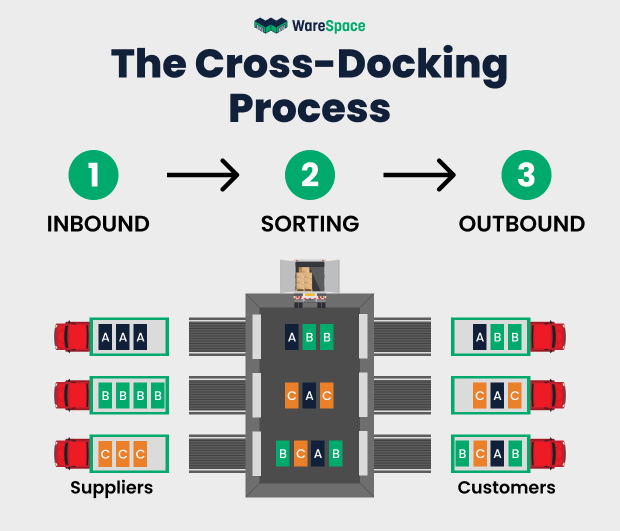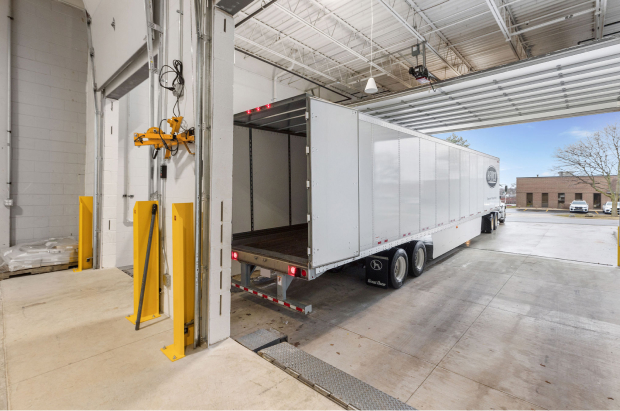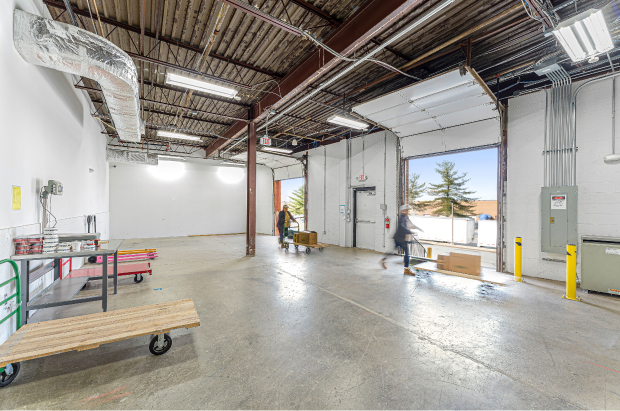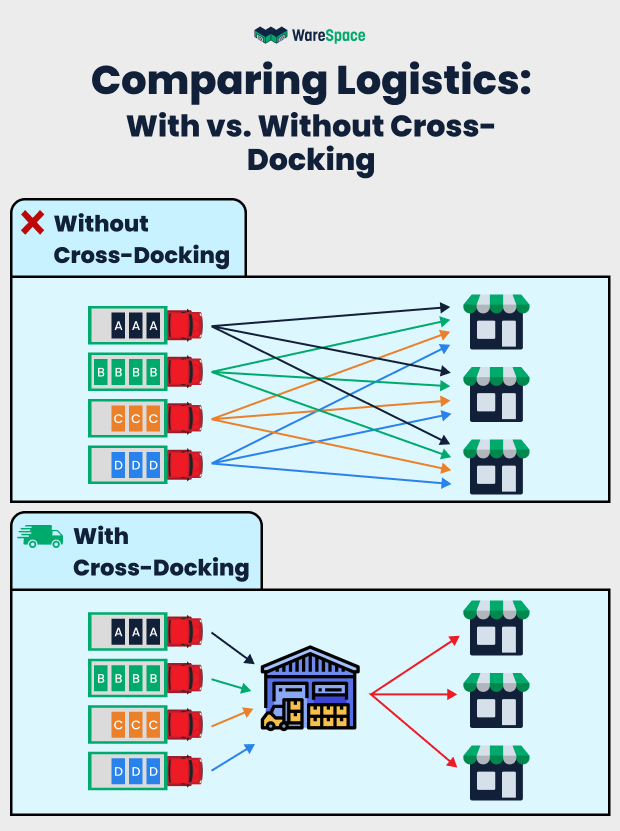Imagine transforming your warehouse operations to be faster, more efficient, and cost-effective almost overnight. That’s the power of cross-docking—a dynamic approach to modern logistics that minimizes storage time and maximizes productivity. In this blog, we dive into the core of cross-docking warehouse design, unveiling the best practices that industry leaders use to streamline their operations.
Whether you’re new to this concept or seeking to enhance your existing setup, you’re in the right place to discover how to effectively apply these strategies to your business for immediate and impactful results.
In this post, we will cover:
- The Fundamentals of Cross-Docking: Learn what cross-docking is and how it compares to traditional warehousing methods.
- Designing Your Warehouse for Efficiency: Explore the essential elements of warehouse design that facilitate successful cross-docking.
- Technological Enhancements: Discover the technologies that can supercharge your cross-docking operations for better coordination and fewer errors.
Understanding Cross-Docking and Its Advantages Over Traditional Warehousing
Cross-docking is a logistics practice where goods are directly transferred from incoming to outgoing transportation, bypassing traditional storage. This swift movement of goods highlights the primary advantages of cross-docking over traditional warehousing: increased efficiency and reduced operational costs.
While traditional warehousing often involves long storage times, cross-docking ensures that products remain in motion, thereby reducing the need for storage space and minimizing handling costs. For businesses looking to streamline operations and decrease lead times, understanding the difference between these two systems is crucial.
Best Practices for Cross-Docking Warehouse Design
Before diving into the specifics, it’s important to grasp the overarching principles that make a warehouse ideal for cross-docking. The layout and design of the warehouse, the strategic placement of dock doors, and the optimization of schedules are foundational to facilitating efficient cross-docking. Each of these components is designed to enhance the flow and handling of goods, significantly impacting the speed and effectiveness of your operations. Let’s examine each of these key elements in detail.
Warehouse Layout and Design
The layout of a warehouse is pivotal in facilitating the smooth flow of goods. Commonly, smaller facilities might opt for an I-shape or a narrow rectangular shape to enhance the efficiency of movement. Larger operations may benefit from different configurations such as L-shape, rectangle, or T-shape, which are chosen based on product turnover rates and specific freight patterns. Selecting the right warehouse shape is the first step in creating an environment conducive to effective cross-docking.
Dock Doors
Strategic placement of dock doors is vital to minimize congestion and maximize operational efficiency. Best practices suggest that doors should not face each other directly; instead, placing them on one wall or at 90 degrees to each other can significantly improve the flow of goods. The number of dock doors should correspond to the size and scope of the operations, ensuring that neither excess capacity nor bottlenecks occur.
Optimizing Inbound and Outbound Schedules
To leverage the full potential of cross-docking, the synchronization of inbound and outbound schedules is essential. This synchronization helps ensure a quick transfer of goods and minimizes delays. Technologies like Electronic Data Interchange (EDI) play a crucial role in facilitating real-time coordination between different segments of the supply chain.
Implementing Technology for Enhanced Cross-Docking
Incorporating technology into cross-docking operations is essential for achieving significant enhancements in efficiency and accuracy. Warehouse Management Systems (WMS) play a crucial role in this regard, offering robust platforms that facilitate the coordination of logistics activities. These systems ensure that information regarding incoming and outgoing shipments is accurate and readily accessible, reducing processing times and the likelihood of errors.
Moreover, technological solutions like automated conveyor belts expedite the physical movement of goods within the warehouse, bridging the gap between receiving and shipping docks without manual intervention. Advanced software systems, such as those that integrate real-time data exchange, allow for seamless communication across the supply chain. Technologies such as RFID (Radio Frequency Identification) and barcode scanning further streamline operations by providing instant data on the goods being moved, thereby enhancing traceability and speed. Together, these technologies not only improve material handling but also bolster operational reliability and efficiency.
Key Elements of Successful Cross-Docking Implementation
Successful cross-docking implementation hinges on several best practices that ensure the operation is both effective and sustainable. Consolidation and deconsolidation strategies are vital as they enable the facility to handle varying shipment sizes and compositions with agility. Consolidation involves grouping smaller shipments into a larger one to optimize transportation, whereas deconsolidation separates large shipments into smaller ones for easier distribution to their final destinations.
Selecting the right products for cross-docking is equally important. Ideally, products with stable demand, long shelf life, and minimal storage requirements are suited for cross-docking. These characteristics ensure that items can be quickly transferred through the warehouse without the need for long-term storage, reducing costs and improving turnover rates.
Furthermore, continuous training and development of staff to handle cross-docking operations can dramatically improve efficiency. Staff should be well-versed in the technologies used and the quick decision-making required in a cross-docking environment. Finally, regular analysis and refinement of cross-docking procedures ensure that the system adapts to changing logistics demands and technological advancements, keeping the operation at peak efficiency.
Cross-docking has become a go-to solution for many businesses grappling with rising customer expectations, intense competition, and the urgent need to cut supply chain costs. This strategy helps businesses deliver products more quickly and efficiently.
While there are numerous supply chain management strategies available, cross-docking stands out, particularly for small and medium enterprises (SMEs), as a method to enhance efficiency and reduce operational costs.
A diverse array of companies, including e-commerce and brick-and-mortar retailers, manufacturers, and freight carriers, utilize cross-docking. In the following sections, you’ll learn what cross-docking is, how it operates, its various types, and how it can significantly benefit your business.
In this post, we will cover:
- Cross-docking boosts delivery speeds and supply chain efficiency by moving goods directly from incoming to outgoing transport, avoiding storage.
- This strategy reduces storage time by quickly transferring products between arriving and departing vehicles.
- Utilized across retail, e-commerce, manufacturing, and freight sectors, cross-docking meets diverse business needs.
- Key benefits of cross-docking include faster deliveries, reduced warehouse use, better inventory control, and lower transport and labor costs.

What Is Cross-Docking?
Cross-docking is a logistics strategy that streamlines the supply chain by enabling the direct transfer of products between incoming and outgoing transportation vehicles. This efficient method minimizes or altogether eliminates the need for warehousing, which traditionally slows down the distribution process. By bypassing this step, businesses can significantly speed up product delivery to customers.
This approach not only accelerates the supply chain but also reduces storage costs and minimizes the handling of goods. As products spend less time in transit and handling is decreased, the risk of product damage is significantly reduced. This makes cross-docking an especially valuable strategy for items that are high in demand or sensitive in nature, ensuring they reach their destinations quickly and in optimal condition.
Why Use Cross-Docking?
Cross-docking streamlines logistics by transferring products directly from incoming to outgoing vehicles, significantly enhancing efficiency and speed. This method reduces costs and accelerates delivery times, making it ideal for scenarios that demand quick turnover. Key benefits include:
- Reduced Storage Costs
- Increased Accuracy
- Faster Delivery Times
- Decreased Product Handling
- Increased Sustainability
Cross-docking proves particularly effective for perishable items, high-demand products, and urgent supplies, where timely and efficient handling is crucial. By integrating cross-docking, businesses can optimize their supply chains, responding swiftly to market demands while cutting down on costs.

Types of Cross-Docking
Cross-docking can be segmented into several types, each designed to meet specific operational needs within the supply chain. Understanding these variations can help businesses choose the most effective strategy to enhance their logistical efficiency. Below, we explore the main types of cross-docking and their unique applications:
Pre-distribution Cross-Docking
Pre-distribution cross-docking involves sorting goods according to their final destinations as soon as they arrive. These items are then immediately loaded onto outbound trucks without ever being stored in the warehouse.
Here’s how it works:
- Direct Transfer: Goods are unloaded from incoming transport, sorted, and loaded onto outbound transport without interim storage.
- Efficiency for Pre-allocated Goods: Ideal for products pre-assigned to destinations, reducing handling and speeding up distribution.
- Use Case: Especially effective for products with predictable demand and distribution schedules, like retail store replenishments.
Post-distribution Cross-Docking
Post-distribution cross-docking allows goods to be stored temporarily at the docking facility until their delivery schedules are fully determined, after which they are quickly dispatched.
Key operational details:
- Brief Storage: Goods are stored temporarily until delivery schedules are confirmed.
- Strategic Consolidation: Suitable for products that require grouping or timing adjustments before final shipment.
- Use Case: Useful for managing products with variable demand or coordinating large-scale distributions.
Continuous Cross-Docking
Continuous cross-docking is characterized by a rapid movement of goods from the inbound truck directly to the outbound truck, with minimal or no dwell time in between.
Process overview:
- Non-stop Flow: Ensures continuous movement of goods through the docking terminal.
- High Turnover Compatibility: Best for items in constant demand, like daily consumer goods.
- Use Case: Optimal for industries dealing with perishable goods or just-in-time supply requirements.
Consolidation Cross-Docking
Consolidation cross-docking involves receiving shipments from multiple sources and combining them into larger, more economical loads for outbound transport.
Operational benefits:
- Merge Shipments: Combines several smaller incoming shipments into one larger outbound load.
- Cost Efficiency: Reduces transportation costs by optimizing load capacity.
- Use Case: Common in logistical setups that aggregate orders from various suppliers before making a combined delivery.
Additional variations
Cross-docking includes specialized methods that cater to unique operational needs, enhancing flexibility and efficiency within supply chains. Here are some notable variations:
Deconsolidation
This method involves breaking down large shipments into smaller, destination-specific lots.
- Targeted Distribution: Facilitates precise delivery by separating bulk shipments into customized orders.
- Use Case: Particularly effective for distribution centers that serve multiple retail locations with different product requirements.
Flexibility and Customization
These practices allow businesses to adapt logistics strategies to meet diverse delivery destinations and requirements.
- Adaptive Logistics: Enables modifications in the shipping process to accommodate specific customer or market demands.
- Use Case: Useful for companies that manage a wide range of products and need to respond dynamically to market changes.
Each type of cross-docking offers distinct advantages and is chosen based on the specific logistical needs and goals of a business. Understanding these variations is crucial for optimizing a company’s supply chain management, ensuring that products are moved efficiently and meet the demands of a fast-paced market.

Industries that Use Cross-Docking
Cross-docking is a strategic choice in various industries, particularly where speed and efficiency in logistics are paramount. Here are some specific industries and situations where cross-docking proves beneficial:
- Retail: Ensures that the latest products are quickly available on shelves, crucial for maintaining customer satisfaction and high turnover.
- Manufacturing: Supports just-in-time production models by facilitating the timely arrival of components, reducing inventory costs and enhancing production efficiency.
- Automotive: Essential for distributing parts and accessories rapidly to meet tight production schedules and maintenance demands.
- E-commerce: Helps manage large volumes of orders efficiently, crucial for businesses that need to deliver products directly to consumers quickly.
- Healthcare: Critical for the quick distribution of medical supplies and pharmaceuticals, where delivery speed can directly impact patient care.
- Food and Beverage: Ideal for managing perishable goods, ensuring they remain fresh by minimizing the time between supply chain stages.
Cross-docking is particularly useful in scenarios that demand:
- High-turnover Products: For items like perishable groceries or trending consumer electronics that must reach consumers swiftly.
- Seasonal Demand: Useful during peak shopping seasons when products must reach the market quickly to meet consumer demand.
- Emergency Supplies: Necessary for rapid distribution of critical supplies in disaster relief or urgent medical situations.
By understanding these applications and the specific needs they address, businesses can more effectively integrate cross-docking into their logistics strategies.

Unlock the Secrets to Small Business Expansion in 2024!
Loaded with crucial trends and statistics, this is your roadmap to dominate the market. Act now – download your free guide and unleash your business’s full potential!
Implementing Cross-Docking in Your Business
Successfully implementing cross-docking in your business involves several key infrastructural and technological considerations:
- Warehouse Design: Facilities must be designed to enable efficient and rapid transfer of goods from inbound to outbound transportation, often involving specific layouts that minimize handling time.
- Technology Utilization: Implementing advanced systems such as Warehouse Management Systems (WMS) and Electronic Data Interchange (EDI) is crucial. These technologies help streamline operations, improve accuracy, and enhance communication across the supply chain.
- Training and Processes: Employees must be trained in the specific processes of cross-docking. Understanding the flow of goods and the technology that supports it is essential for maintaining efficiency.

Advantages and Disadvantages of Cross-Docking
Cross-docking can offer substantial benefits to companies by enhancing efficiency and reducing costs, but its successful implementation depends heavily on the ability to manage the inherent complexities and upfront investments.
Advantages of Cross-Docking
Cross-docking provides several key benefits that make it an attractive option for many businesses looking to streamline their logistics:
- Increased Efficiency: By moving goods directly from incoming to outgoing trucks without storage, cross-docking reduces the time products spend in the supply chain, leading to faster overall delivery times.
- Reduced Costs: Eliminating the need for warehouse storage not only reduces the costs associated with storing goods, but also lowers labor costs as fewer workers are needed for order picking and inventory management.
- Decreased Inventory: Cross-docking minimizes the amount of inventory that a company must hold at any one time, reducing inventory holding costs and the risk of inventory depreciation or obsolescence.
- Enhanced Product Quality: Since goods are handled less frequently, there is a reduced risk of damage, maintaining higher product quality and customer satisfaction.
- Environmental Benefits: Fewer storage requirements mean less energy consumption and a smaller carbon footprint, contributing to more sustainable operations.
Disadvantages of Cross-Docking
Despite its advantages, cross-docking also presents several challenges that require careful consideration:
- Complex Coordination: Effective cross-docking requires a high level of coordination between suppliers, transportation networks, and docking facilities to ensure that goods are received, sorted, and shipped in a timely manner.
- High Initial Setup Costs: Establishing a cross-docking system can be expensive. It often involves significant investments in facility redesign, technology such as WMS and TMS, and training for personnel.
- Limited Product Suitability: Not all products are suitable for cross-docking. Products that need quality inspections, have a high variability in demand, or are not delivered on predictable schedules may not benefit from cross-docking.
- Dependence on Reliable Suppliers and Carriers: Since cross-docking relies heavily on timing, any delays in the supply chain can disrupt the entire operation, requiring dependable partners and robust contingency planning.
- Demand for Advanced Technology: To manage the complexity and keep operations running smoothly, cross-docking depends on advanced technologies for tracking and managing logistics, which may represent a barrier for smaller or less technologically advanced companies.
Understanding both the advantages and the disadvantages is crucial for any business considering this logistics strategy.
How SMEs can Utalize Cross-Docking
For businesses looking to expedite product delivery and streamline operations, cross-docking presents a compelling strategy. Especially for small and medium enterprises (SMEs), this method offers significant benefits by optimizing the flow of goods and minimizing associated costs. One significant challenge for SMEs is the substantial upfront investment required for infrastructure and technology.
WareSpace offers an innovative solution that allows SMEs to bypass these initial costs. By providing the opportunity to rent smaller, equipped warehouse spaces, including amenities like loading docks, WareSpace enables SMEs to access cross-docking facilities without the heavy financial burden. This arrangement allows businesses to maintain flexibility, scale operations according to current needs, and manage costs more effectively.
If you are interested in exploring how renting a small warehouse space can benefit your business, contact us today! Our team is ready to help you streamline your operations and implement cross-docking effectively.
Does your space include everything on our warehouse equipment list? For employees in your warehouse to operate safely and efficiently, they need to have the right tools at their disposal. This warehouse equipment list specifically outlines everything your facility needs to reduce wasted time and get orders out as quickly as possible.
Warehouse Tools and Equipment List
Any warehouse tools and equipment list should include solutions for storing, conveying, lifting, organizing, packaging, and shipping products. Plus, you’ll want to include any safety and maintenance tools.
1. Storage Equipment
Storage equipment makes efficient use of warehouse space. Pallet racks, shelves, totes, bulk boxes, and bins facilitate the neat organization of products. In a warehouse that effectively uses these storage systems, workers can easily speed up their picking rates.
Pallet racks have various designs based on how workers stock and remove products from them. For first-in, first-out (FIFO) storage, goods arriving at the warehouse the earliest are the first to leave. Racks useful for FIFO storage include:
- Selective pallet racks
- Push-back racks
- Pallet flow racks
- Drive-through racks
In facilities that use last-in, first-out (LIFO) storage, goods that arrive most recently leave sooner than products that came earlier. Warehouses that need more dense storage of non-perishable goods use LIFO. Rack designs for LIFO include:
- Double deep racks
- Drive-in racks
To enhance the effectiveness of storage equipment, use barcode labels that correspond to the products on the shelves or in the bins. Workers scan these barcodes to verify that they pulled the correct product, and to update the warehouse management system (WMS) information on inventory counts.
2. Conveying Devices
Conveying devices move products from one part of the warehouse to another without needing a person to carry them. Differences among these types of equipment depend on the direction that the equipment moves in. Options include:
- Belt conveyors
- Spiral conveyors
- Vertical conveyors
- Gravity-fed conveyors
Powered conveyors should have emergency stop cables along their lengths to stop the belt at any time. Employee work areas also need emergency stop buttons for automatic conveyors, per OSHA requirements.
3. Lifting Equipment
Lifting equipment reduces worker strain due to picking up heavy products or containers. Lifting devices safely move heavy products or pallets filled with goods. Examples include:
- Hand trucks or dollies
- Pallet jacks
- Pallet stackers
- Forklifts or lift trucks
Workers should have clear instructions on safely using lifting equipment. For forklifts, users must have training and certification in their use, according to OSHA.
4. Organizational Tools
Organizational tools include everything needed to track the inventory in a warehouse and order products as needed. Examples include:
- Barcode scanners for picking
- Warehouse management systems (WMS)
- Labels on storage containers
These organizational tools ensure inventory counts stay updated and accurate.
5. Packaging and Shipping Equipment
Your warehouse should have a dedicated area for packaging and shipping products. Equipment in this area allows workers to prepare all orders for shipment without leaving the area, if possible. Examples of essential packaging and shipping equipment include:
- Varied packaging types
- Stretch wrappers
- Industrials scales
- Packing tables
- Lift tables
- Strapping tools
With a well-stocked packaging and shipping area, workers don’t need to leave the space to get the equipment they need.
6. Safety Gear
Safety gear is vital for protecting workers and preventing accidents. The specific types of safety equipment in a small warehouse depend on the layout of the facility, other equipment installed, and the types of products stored. Some common types of safety equipment include:
- First aid kits
- Guard rails
- Fall protection equipment
- Wheel chocks for transport trucks at the dock
- Dock levelers
- Dock bumpers
- Hard hats
- Corner, column, and rack protectors
Always refer to OSHA requirements when creating a list of safety gear your warehouse needs.
7. Maintenance Tools
Maintenance tools reduce the operational problems of other warehouse equipment. Cleaning equipment also maintains the warehouse itself. Examples of maintenance tools include:
- Replacement batteries for materials handling equipment
- Maintenance plan for all equipment
- Basic repair tools
- Basic cleaning supplies, such as mops, brooms, dusters
The Importance of Investing in Warehouse Equipment
The right warehouse equipment improves productivity and the use of space within the warehouse, and improves worker safety.
Productivity
Bins, racks, and other storage equipment improves the organization of the products to make it easier for workers to fulfill orders. Industrial racking maximizes the number of goods stored within the warehouse space by increasing vertical storage space. Conveyor equipment automates movement from one side of the warehouse to another, cutting down on the time needed to deliver products to the packaging and shipping area. Lift trucks or pallet jacks safely move the pallets vertically to reduce the time needed for storage.
Cutting even a few seconds from each warehouse task adds up to a significant amount of time saved for each order. For small businesses that need to grow, faster order processing could create the necessary edge over the competition.
Safety
Your warehouse must have safety equipment to meet requirements from the Occupational Safety and Health Administration (OSHA). Having the proper gear can prevent injuries or even death. In 2021, the warehousing sector had 46 total deaths and 5.5 injuries per 100 workers.
Hard hats, steel-toed boots, guardrails, barriers, and first aid kits help workers to do their jobs with less danger. Installing safety equipment reduces warehouse hazards and makes the facility safer. A safer warehouse that has fewer accidents reduces the time lost due to worker injuries.
Employee Retention
In 2022, the warehousing industry faced serious shortages of workers. A survey showed that 44% of warehouse managers could not find enough qualified workers to fill their open positions. Turnover was almost equally high, with an industry rate of 43%. A lack of workers, not having enough trained employees, needing to train workers, and high turnover rates cut productivity in warehouses by up to 50%. By improving conditions and updating equipment, warehouses can keep trained employees longer and avoid these productivity drops.
Warehouse work puts heavy demands on the human body, and the best warehouse equipment lessens the strain that workers experience. Investing in warehouse equipment that improves productivity helps workers do more in less time, and helps companies avoid the hidden costs of employee turnover.
Are You Missing Any Tools From Our Warehouse Equipment List?
Although not company specific, the equipment list above outlines what your warehouse should have to ensure productive and safe operations. If you’re looking at WareSpace to fill your warehouse needs, you’ll find professional-grade storage racking, pallet jacks, conference rooms, wi-fi, electricity, and many more amenities all included in our rates. With our variety of warehouse sizes, we’re sure you’ll find the perfect space for your small business.
Do you think that your business is too small to benefit from access to a warehouse loading dock? If you need the added storage of a small warehouse space, you also need a docking area. An efficient loading dock is one of the essential tools to improve operations and set yourself up for future growth.
Why Loading Docks?
Access to a warehouse loading dock makes it faster and easier to get your goods to customers and restock your supplies. You don’t need to send out truckloads of goods to benefit from docking areas — carriers can handle full truckloads or single pallets. Loading docks give you the convenience of easy shipping and receiving without having to leave your space.
4 Benefits of Renting a Small Warehouse Space with a Loading Dock
Operational improvement is at the top of the list, but there are a few other benefits to renting a small warehouse space with a loading dock.
1. Increased Safety
A loading dock equipped with appropriate handling tools offers a safer alternative to receiving large shipments than a back door. Trying to unload trucks without docking bays means moving goods outside in all types of weather. Rainy or icy conditions can be dangerous for anyone loading or unloading. Loading docks provide a protected space for safely unloading trucks without exposing workers or products to inclement weather.
It’s also hard to control a truck’s movement without a loading dock. Most docks typically have wheel chocks or other methods to prevent truck creep. This creep is the unintended movement of the vehicle during loading or unloading, which can cause serious injury. Tools around loading docks that prevent this creep make the area safer for those using it.
While loading docks provide a safer alternative than parking lots to unload trucks, everyone must still exercise caution when using these spaces. To ensure maximum safety around the loading dock, always follow safety guidelines from the Occupational Safety and Health Administration (OSHA). These safety rules include securing dock plates, keeping clear of edges around the dock, and never jumping from the dock.
2. Efficiency
Over time, the design of loading docks has evolved to optimize efficiency for loading and unloading trucks. Most are physically designed and constructed to make shipping and receiving easy. For instance, outside areas around the loading docks should include space for trucks to turn around, back into the docks, and pull out of the area, even if there are other vehicles present.
Inside, the layout should be structured so you can quickly and easily access the loading dock area. The best layout for your space is one that’s designed to keep the time needed to stock items, pick products, and ship at a minimum.
3. Flexibility
Most small businesses intend to grow over time. Loading docks give your business the flexibility it needs to increase your inventory. Paired with a shared warehouse that allows you to rent several different size spaces, your business will be set up for growth. You can receive more products, store more goods, and increase sales.
4. Labor and Timesaving
The enhanced efficiency and safety of loading docks also make them time-saving tools. Materials handling tools such as pallet jacks and dollies allow workers to effortlessly move goods. It also saves time because there’s less chance that workers could sustain injuries that might cause them to miss work
Spending less time getting products to the delivery trucks gives workers more time for other tasks. With their extra time, workers can fulfill more orders, prepare additional shipments, or store extra products.
Loading Docks Are Available at Our Facilities
Businesses of all sizes can benefit from the safety, time-saving, and flexibility of warehouse loading docks. But, loading docks are only one of the many amenities that WareSpace offers its tenants. Our small warehouse spaces come equipped with the tools you need to begin to make the most of the storage and shipping space. For more information, give us a call or contact us online to book a tour.
